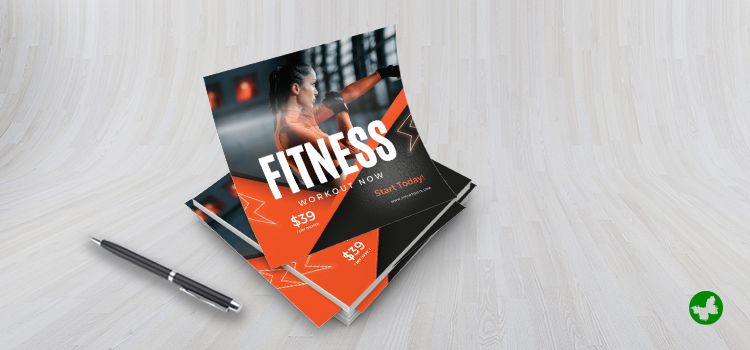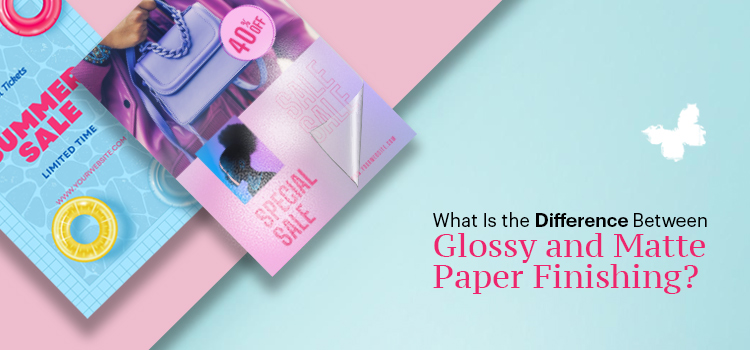In the print industry, you’ll often encounter two types of print finishes: glossy and matte. Each one has its unique characteristics and is better suited for different projects, depending on the desired effect and the printing application. They add a distinct texture and appearance to the print products.
In this post, we’ll explore matte and glossy finishes, compare their features, explain their pros and cons, and advise on their applications. Let’s begin by answering the most fundamental question: What is the difference between glossy and matte print finishes?
Contents
Glossy and Matte Print Finishes: What Is the Difference?
For printed materials, glossy and matte finishes provide unique tactile and visual experiences. For your next print project, let’s learn about the benefits and drawbacks of glossy and matte paper finishes so you can make an informed decision.
What Is a Glossy Finish?
The term “glossy finish” describes a smooth, shiny, and reflective surface that is frequently applied to materials like paint, paper, or photos. It is distinguished by its “shiny” or “aesthetic” appearance, which results from its high light reflection capacity.
This coating allows the colours on the print to appear more vibrant and produces sharp images with crisp contrast. Many choose the glossy finish for marketing materials, magazines, and business cards because it makes images stand out and appear more professional.
Pros:
- Produces vibrant, rich colours with improved contrast;
- Gives a professional, high-quality appearance;
- Enhances sharpness and detail in prints.
Cons:
- Prone to fingerprints and dirt;
- Can reflect light, causing glare and making it harder to read in certain lighting conditions;
- May be perceived as too polished or commercial for some projects
What Is a Matte Finish?
The surface appearance of a matte finish is dull and non-glossy, with a soft, velvety texture and low reflectivity. A coating that scatters light instead of reflecting it is applied to print products to create matte finishes, which give them a soft, non-glossy look. To achieve this, a matte finish is applied to the paper or other substrate to produce an uneven surface.
There are matte coatings, matte laminations, and matte varnishes. All of them offer better readability, which makes this type of finish ideal for brochures and menus. Smudges and fingerprints are less visible due to the scattering effect, which also lessens glare.
Pros:
- Less reflective, making it easier to read in various lighting conditions;
- Resistant to fingerprints and smudges;
- Provides a subtle, elegant appearance that works well for certain projects.
Cons:
- Colours may appear duller compared to glossy prints;
- May lack the sharpness and detail found in glossy prints;
- Susceptible to ink bleed, particularly when using inkjet printers.
Now that we’ve established the key features of matte and glossy print finishes, let’s explore the next question: Which one is better, matte or glossy paper?
Glossy or Matte: Which One Fits Your Project?

When comparing glossy and matte print finishes, neither is fundamentally superior to the other. The choice ultimately depends on the individual project, its intended purpose, and one’s personal preferences. To help you decide, consider the following factors:
Intended Use
Think about where and how you are going to use the final product. If you need promotional materials or photographs with vibrant colours and sharp images that catch the eye, glossy paper would be the better choice. However, if your project requires a refined, delicate look, such as wedding invitations or fine art prints, matte paper would be more suitable.
Viewing Conditions
Consider the lighting conditions where your prints will be displayed or read. Matte paper is typically better for readability in a variety of lighting conditions, as it does not reflect light and cause glare like glossy paper. If your print has a distinct colour scheme and you prefer to show the details, the glossy finish will be the ideal choice.
Personal Preference
Ultimately, the choice between matte and glossy finishes comes down to personal preference. Some people prefer the rich, saturated colours and sharpness of glossy prints, while others favour the subtle, understated elegance of matte paper. Consider your aesthetic preferences and the overall tone you want your project to convey when selecting the paper finish.
Read More: A Comparative Guide to Understanding Raised UV and Raised Foil Finishing
Main Applications of Glossy and Matte Print Finishes

To determine whether to order matte or glossy prints, consider the purpose and requirements of the specific project:
- Photographs: Photographers often prefer glossy paper due to its ability to enhance colours and create a polished, professional look. However, if you desire a more subtle finish that reduces glare, matte paper is also an excellent choice, particularly for black and white or vintage-style photos.
- Marketing Materials: Glossy paper is popular for marketing materials, such as brochures, flyers, and posters, as it captures attention with its vibrant, high-contrast images. However, if you prefer a softer, more refined appearance for your marketing materials, matte paper may be a better choice.
- Stationery and Invitations: For items such as business cards, letterheads, and invitations, matte paper typically creates a more elegant and sophisticated impression. It also resists fingerprints and smudging, which is important for frequently handled materials.
- Fine Art Prints: Fine art prints often use matte paper for its ability to reproduce texture, ensuring a more accurate representation of the original artwork. Additionally, the muted colours and lack of glare can enhance the depth and perception of certain prints.
Final Words
The selection between matte and glossy paper is not a one-size-fits-all solution. Each finish has its distinct characteristics that can greatly enhance the purpose and visual outcome of your project. Glossy finishes enhance vibrancy and sharpness, making images pop. On the other hand, matte finishes offer elegance and readability with less glare. Personal preferences also play a crucial role in this decision, as the aesthetic appeal can vary from person to person. Therefore, when choosing between glossy and matte print finishes, consider your project’s requirements, targeted audience, and message.
Considering these factors will help you make an informed decision that maximizes your project’s impact and effectiveness. You can also consult with our expert team at ButterflyGP to make sure which print finish better fits your project. We are here to guarantee you a high-quality final product at every stage of your print order.
